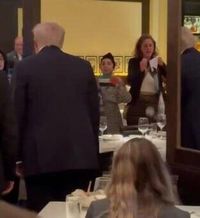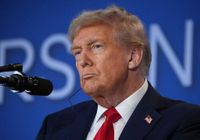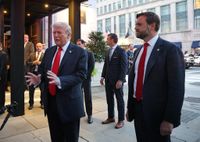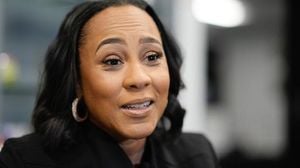On the evening of September 9, 2025, what was meant to be a triumphant display of leadership for President Donald Trump in Washington, D.C. quickly turned into a scene of public confrontation and protest. Trump, accompanied by Vice President J.D. Vance, Secretary of State Marco Rubio, Defense Secretary Pete Hegseth, and other cabinet members, arrived by motorcade at Joe’s Seafood, Prime Steak & Stone Crab—a well-known restaurant just blocks from the White House. The visit was intended as a symbolic gesture, highlighting the president’s efforts to restore law and order in the nation’s capital through aggressive crime-fighting measures involving federal agents and National Guard troops.
According to TIME, the president’s arrival was met with mixed reactions. Some diners cheered and applauded as Trump entered, shaking hands and smiling for cameras. In a moment captured on social media, Trump quipped to the crowd, “We have a safe city, so that’s good. Enjoy yourself. You won’t be mugged going home. Have a good time, everybody. Don’t drink too much!” The remark was a not-so-subtle nod to his administration’s recent crackdown on crime in D.C., which had included thousands of arrests and the clearing of numerous encampments across the city.
Yet, the carefully staged dinner was soon overshadowed by chaos. As Trump and his entourage made their way to their table, a small but vocal group of pro-Palestine protesters suddenly stood up in the dining room. According to Latin Times and footage reviewed by BBC, the demonstrators waved Palestinian flags and banners, chanting, “Free D.C.! Free Palestine! Trump is the Hitler of our time!” The disruption caught the attention of everyone in the restaurant, with some patrons voicing support for Trump, shouting back “yes he is [welcome],” while others looked on in silence or confusion.
Trump, visibly irritated, paused mid-stride and glared at the protesters. With a grin aimed at the cameras, he signaled to his security detail and said, “Come on, lets go, get them outta here.” Secret Service agents promptly moved in to escort the demonstrators out of the restaurant. As they were being removed, one protester shouted, “He’s not welcome in D.C.,” while another declared, “He is terrorizing communities all over the world, from Puerto Rico… from Palestine… to Venezuela, he is terrorizing communities. He is not welcome to D.C., he is not welcome to Palestine. Palestine is not for sale. Shame on you all!”
The scene outside was no less intense. Onlookers gathered, some booing and shouting profanities at the president’s motorcade. The protesters continued their chants on the sidewalk, referencing Trump’s federal takeover of the D.C. police force and his broader record on foreign and domestic policy. According to CNN, the antiwar group Code Pink, known for its feminist grassroots activism against U.S. wars and militarism, later confirmed they had organized the demonstration. Co-founder Medea Benjamin explained that the protest was meant to expose what activists saw as hypocrisy in celebrating law and order while, in their view, waging wars and cracking down on marginalized communities. “They feast while Gaza starves,” Benjamin wrote, summarizing the activists’ motivation for the action.
The restaurant episode was only the latest in a string of public challenges for Trump. Just two days earlier, he had appeared at the U.S. Open final in New York, where his image on the big screen provoked loud boos and anti-Trump chants from the crowd. Broadcasters reportedly tried to mute the sound for television audiences, but the reaction was unmistakable—a sign of the deep polarization that continues to follow the former and current president wherever he goes.
Beyond the drama in the restaurant, the events of September 9 were further complicated by fast-moving developments in the Middle East. Earlier that day, Trump had addressed reporters outside Joe’s Seafood, expressing his displeasure over an Israeli airstrike targeting Hamas officials in Doha, Qatar. “We want the hostages back, but we are not thrilled about how that went down today,” he said, as reported by TIME. When pressed on whether he was surprised by Israel’s actions, Trump replied, “I’m never surprised by anything, especially when it comes to the Middle East.”
On his Truth Social account, Trump elaborated on his administration’s response, stating, “I immediately directed Special Envoy Steve Witkoff to inform the Qataris of the impending attack, which he did, however, unfortunately, too late to stop the attack. I view Qatar as a strong ally and friend of the U.S., and feel very badly about the location of the attack.”
Meanwhile, Israel continued to expand its military operations in Gaza City, issuing “urgent” evacuation orders to all residents across multiple neighborhoods. The United Nations Office for the Coordination of Humanitarian Affairs (OCHA) warned that the city’s coastline was already packed with makeshift shelters, forcing newly displaced families to sleep dangerously close to the water’s edge. The humanitarian situation in Gaza remained dire, with international observers expressing alarm at the growing crisis.
Back in Washington, the protest at Joe’s Seafood was emblematic of the broader tensions surrounding Trump’s presidency—both his policies at home and his approach to foreign affairs. Supporters point to the president’s efforts to restore order in the capital, citing reduced crime rates and the visible presence of law enforcement as signs of success. “We have a safe city,” Trump had declared, and for some in the restaurant, that promise resonated.
But for critics, the evening’s confrontation was a stark reminder of what they see as the exclusionary and heavy-handed nature of Trump’s leadership. The chants of “Free D.C.! Free Palestine!” and accusations of terrorizing communities reflected deep-seated frustrations among activists and many residents of the city, who have long opposed Trump’s stance on policing, immigration, and U.S. involvement in foreign conflicts.
The incident also highlighted the ongoing role of grassroots protest in American political life. Code Pink’s quick mobilization and the viral spread of protest footage on social media underscored how public dissent continues to shape the national conversation, even in spaces as seemingly controlled as a presidential dinner.
As the dust settled, it was clear that Trump’s attempt to project strength in the heart of Washington had instead become another flashpoint in a deeply divided nation. The restaurant protest, set against the backdrop of violence in Gaza and political unrest at home, offered a vivid snapshot of the challenges facing the president—and the country—as 2025 unfolds.






